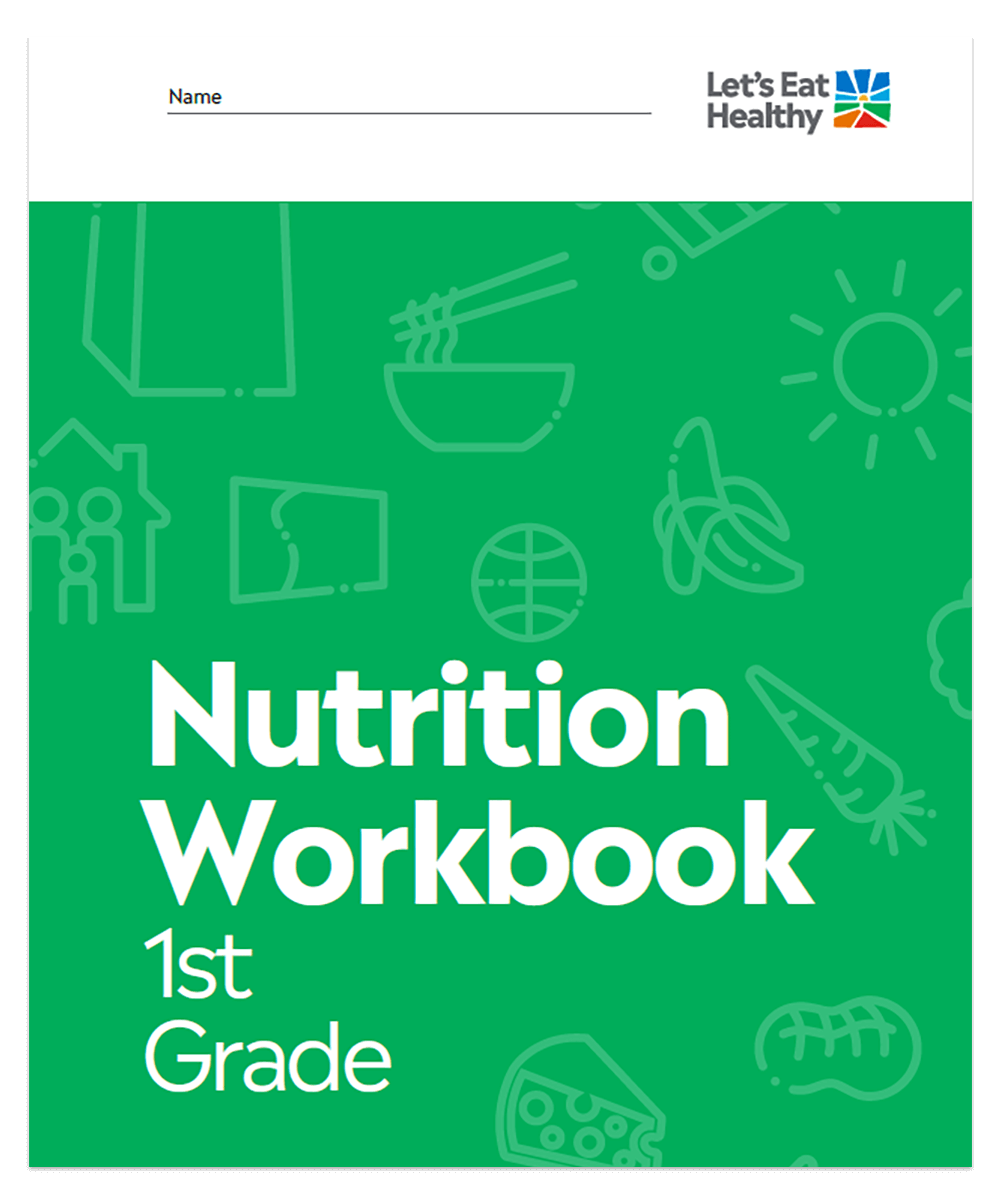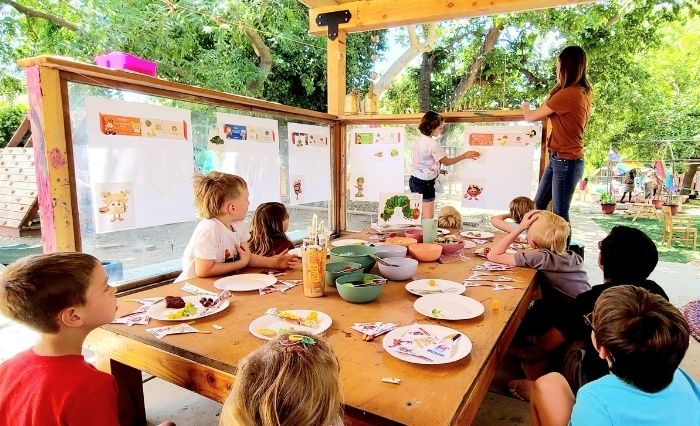By: Michaela Nealy, 1st Grade Educator
.png?sfvrsn=d5b18fd0_12)
As an elementary school teacher, nutrition has always been an important part of my classroom curriculum because I believe lifelong health and success begins with nutrition education. I have seen first-hand how healthy foods benefit students’ ability to learn and actively participate in class. It’s not surprising that well-nourished bodies lead to well-nourished minds, and nutrient-rich foods are more important than ever as we recover from the impacts of the pandemic.
Why I Teach Nutrition
I went into teaching to make a difference. Early on, I knew that I wanted to give back in an impactful way. For me, that meant focusing on elementary students in underserved and marginalized communities. I wanted to support our most vulnerable students by educating, inspiring and empowering them to live healthier, more successful lives. In my experience, nutrition directly impacts the health of not only students but their families as well. By teaching nutrition, I could achieve a positive trickle-down effect on entire families. When students are excited about what they learn at school, they are more likely to share that information at home. Inspiring children to make healthier choices can help improve their lives, the health of their families and, ultimately, communities at large.
 I have used Dairy Council of California free nutrition education resources since 2017, inspired by a Mobile Dairy Classroom assembly that visited my school. The assembly taught agricultural literacy and the basics of nutrition; I was inspired and wanted
to learn more. I found the grade-specific nutrition resources to be simple and interactive, which is vital to keeping students engaged, especially in elementary school. The Let’s Eat Healthy curriculum is developed by nutrition and education
experts and aligned to Common Core State Standards. As a bonus, it is fun for students to learn and practice in real-life settings. The entire teaching kit—from lesson plans to classroom workbooks and posters—is provided free of charge
for California teachers.
I have used Dairy Council of California free nutrition education resources since 2017, inspired by a Mobile Dairy Classroom assembly that visited my school. The assembly taught agricultural literacy and the basics of nutrition; I was inspired and wanted
to learn more. I found the grade-specific nutrition resources to be simple and interactive, which is vital to keeping students engaged, especially in elementary school. The Let’s Eat Healthy curriculum is developed by nutrition and education
experts and aligned to Common Core State Standards. As a bonus, it is fun for students to learn and practice in real-life settings. The entire teaching kit—from lesson plans to classroom workbooks and posters—is provided free of charge
for California teachers.
Teaching nutrition has always had a profound impact on my students, providing them with the knowledge, confidence and inspiration to make healthier eating choices. In fact, after teaching the nutrition lessons just once per week for a total of two months,
I observed students bringing in healthier snacks from home and making healthier food choices during lunch. Additionally, they were able to identify foods from the different food groups, and they held themselves and their peers accountable for the
foods they ate, empowering each other to eat more healthfully.
During the pandemic, supporting my students has become more challenging but also more important. Nutrition education is a relatable topic that enables me to teach valuable life skills and fulfill educational requirements. As I head back to the classroom for in-person instruction in the fall, using the Let’s Eat Healthy curriculum is more critical than ever.
All Students Deserve Nutrition Equity
.png?sfvrsn=cf62932a_2) Nutrition equity means ensuring that all people have the ability to access nutritious
and culturally appropriate foods, and this is a sentiment I wholeheartedly believe in. I have seen how food insecurity can impact students’ overall education. While giving kids food is a start, it’s not enough. All kids deserve access
not just to food but to nutritious foods and nutrition education, which together support growth and development, academic achievement and lifelong success.
Nutrition equity means ensuring that all people have the ability to access nutritious
and culturally appropriate foods, and this is a sentiment I wholeheartedly believe in. I have seen how food insecurity can impact students’ overall education. While giving kids food is a start, it’s not enough. All kids deserve access
not just to food but to nutritious foods and nutrition education, which together support growth and development, academic achievement and lifelong success.
The coronavirus pandemic presented unexpected challenges for teachers and students alike. Virtual learning and stay-at-home orders increased sedentary behaviors and obesity for students in California and across the country. According to new research, time out of school has been linked to weight gain, especially among Hispanics, African Americans and children who were already overweight.1 In the past year, children spent more time in front of computers, televisions and video screens and less time outside playing with friends. Coupled with all-day snacking, often on high-calorie, low-nutrition foods, the pandemic fostered unhealthy outcomes. In fact, I witnessed students eating desserts on Zoom before lunchtime!
Working at a Title 1 school in a low-income district in Stockton, California, I knew many of my students relied on the school meal program as the primary source of nutrition and possibly even the only meal they would eat each day. Families with limited food dollars often lack the means to secure nutritious foods. Even with free meals provided by drive-through school foodservice, many of my students’ families didn’t have reliable transportation to pick up the free meals that were available.
Simple Classroom Solutions to Improve Food Equity
Prior to the pandemic, I had students complete a nutrition activity in which they listed what they had eaten for dinner. One student was struggling with the activity and getting very frustrated. I found that he couldn’t complete it because his family didn’t have any food for dinner the night before. It was then that I realized the delicate balance between nutrition education and food access. As educators, we can teach kids to eat healthfully, but it’s more effective when they have access to healthful foods. To ensure students are supported, education is not enough. It is also important to help connect families to the many food resources that are available to ensure they have access to healthy foods at home.
.png?sfvrsn=b400ca60_2) While it may seem daunting, just a little bit of creativity can provide a food
solution for students. This past school year, I was able to coordinate directly with parents of my students who were unable to pick up their free meals due to transportation issues. I started personally delivering the free meals to their houses so
families would have the food they so desperately needed. I’ll never forget the experience, and I am grateful to have helped my student families in such a meaningful way.
While it may seem daunting, just a little bit of creativity can provide a food
solution for students. This past school year, I was able to coordinate directly with parents of my students who were unable to pick up their free meals due to transportation issues. I started personally delivering the free meals to their houses so
families would have the food they so desperately needed. I’ll never forget the experience, and I am grateful to have helped my student families in such a meaningful way.
As teachers return to the classroom this fall, in-person teaching allows for added opportunities. Creating a “share bin” is an easy way to turn food waste into shareable snacks for kids in need. Bins are simply set up in the cafeteria or classroom for students to place unopened, non-perishable food items that would otherwise be thrown out. These bins are open and made available to all students, allowing them to select foods from the bin to eat or take home, no questions asked.
I also like to keep clementine oranges and other small snacks in my classroom for children that may come to school hungry or arrive too late for the school breakfast program. Giving kids something healthy—as simple as a carton of milk—before starting the school day provides nourishment to get through the day, and behavior and concentration improve immensely as a result. This may be the most important work I do as a teacher—supporting my students by showing I care about their well-being while also serving as a positive role model.
Nutrition Education as a Priority Subject This Fall
Back-to-school preparation includes reviewing the lessons I plan to cover, with nutrition education one of my first priorities. This is important because after a year of remote learning with decreased access to healthy food and physical activity, I know my students will need a reset. By teaching students nutrition, they are able to prioritize their health and have the knowledge they need to recognize and value healthy foods, which are essential to fueling their bodies and minds. I will be emphasizing a physical fitness component as well. All educators know that students are struggling academically from lost time in the classroom, but education is more than teaching math or English; it’s also helping students learn behaviors to support good health, which is essential as we enter this post-pandemic school year.
Sourcing information can be a challenge, which is why I love using the Let’s Eat Healthy curriculum for K-12. After a year of quarantined living and weight gain, students need support for healthier living. That is why I am encouraging all educators to join me in kicking off the new school year by teaching nutrition education and applying simple, healthy approaches that can make a significant difference in the lives of students and their families. Supporting healthier students and communities cannot be done alone, but it must start somewhere. As educators, we play a vital role in our students’ lives. By teaching nutrition education, we can get healthy together!
PE teacher Scott Brown highlights his experience in teaching nutrition education with Let’s Eat Healthy "Exercise Your Options" curriculum.
.png?sfvrsn=3ccbb8d5_4)
Newly revised Kindergarten, 1st and 2nd grade programs aim to help students learn, play and grow by exploring and applying key nutrition concepts.

Subscribe to our blog to stay up to date on the latest news, products, and more.